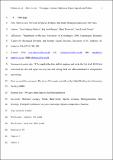Files in this item
More is less : net gain in species richness, but biotic homogenization over 140 years
Item metadata
| dc.contributor.author | Finderup Nielsen, Tora | |
| dc.contributor.author | Sand-Jensen, Kaj | |
| dc.contributor.author | Dornelas, Maria | |
| dc.contributor.author | Bruun, Hans Henrik | |
| dc.date.accessioned | 2020-07-31T08:30:04Z | |
| dc.date.available | 2020-07-31T08:30:04Z | |
| dc.date.issued | 2019-10-01 | |
| dc.identifier | 260458696 | |
| dc.identifier | 2dd52bed-4f0e-43fb-9d56-785c8b2b2dbc | |
| dc.identifier | 85072233943 | |
| dc.identifier | 000479549000001 | |
| dc.identifier.citation | Finderup Nielsen , T , Sand-Jensen , K , Dornelas , M & Bruun , H H 2019 , ' More is less : net gain in species richness, but biotic homogenization over 140 years ' , Ecology Letters , vol. 22 , no. 10 , pp. 1650-1657 . https://doi.org/10.1111/ele.13361 | en |
| dc.identifier.issn | 1461-023X | |
| dc.identifier.other | RIS: urn:62728B0A0F5F9FDD35894F34F9DB6053 | |
| dc.identifier.uri | https://hdl.handle.net/10023/20380 | |
| dc.description | The research was funded by the ‘15. June Foundation’. MD was funded by a Leverhulme Fellowship. | en |
| dc.description.abstract | While biodiversity loss continues globally, assessments of regional and local change over time have been equivocal. Here, we assess changes in plant species richness and beta diversity over 140 years at the level of regions within a country. Using 19th-century flora censuses for 14 Danish regions as a baseline, we overcome previous criticisms concerning short time series and neglect of completely altered habitats. We find that species composition has changed dramatically and directionally across all regions. Substantial species losses were more than offset by large gains, resulting in a net increase in species richness in all regions. The occupancy of initially widespread species increased, while initially rare species lost terrain. These changes were accompanied by strong biotic homogenization; i.e. regions are more similar now than they were 140 years ago. Species declining in Denmark were found to be in similar decline all over Northern Europe. | |
| dc.format.extent | 4140023 | |
| dc.language.iso | eng | |
| dc.relation.ispartof | Ecology Letters | en |
| dc.subject | Baseline | en |
| dc.subject | Beta diversity | en |
| dc.subject | Biodiversity | en |
| dc.subject | Historical ecology | en |
| dc.subject | Homogenization | en |
| dc.subject | Landscape | en |
| dc.subject | Plants | en |
| dc.subject | Principal coordinates analyses | en |
| dc.subject | Species composition | en |
| dc.subject | Species richness | en |
| dc.subject | QH301 Biology | en |
| dc.subject | DAS | en |
| dc.subject.lcc | QH301 | en |
| dc.title | More is less : net gain in species richness, but biotic homogenization over 140 years | en |
| dc.type | Journal article | en |
| dc.contributor.institution | University of St Andrews. School of Biology | en |
| dc.contributor.institution | University of St Andrews. Centre for Biological Diversity | en |
| dc.contributor.institution | University of St Andrews. Fish Behaviour and Biodiversity Research Group | en |
| dc.contributor.institution | University of St Andrews. Marine Alliance for Science & Technology Scotland | en |
| dc.identifier.doi | 10.1111/ele.13361 | |
| dc.description.status | Peer reviewed | en |
| dc.date.embargoedUntil | 2020-07-31 |
This item appears in the following Collection(s)
Items in the St Andrews Research Repository are protected by copyright, with all rights reserved, unless otherwise indicated.

